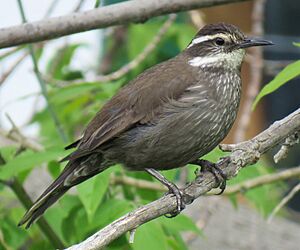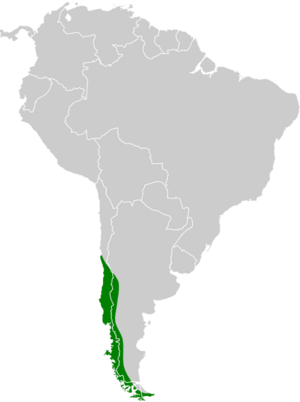Dark-bellied cinclodes facts for kids
Quick facts for kids Dark-bellied cinclodes |
|
|---|---|
 |
|
| Conservation status | |
| Scientific classification | |
| Genus: |
Cinclodes
|
| Species: |
patagonicus
|
 |
|
The dark-bellied cinclodes (Cinclodes patagonicus) is a cool bird that belongs to the ovenbird family, called Furnariidae. You can find this bird in Argentina and Chile, mostly near water.
Contents
Meet the Dark-bellied Cinclodes
This bird is about 18 to 20 centimeters (7 to 8 inches) long. It weighs around 36 to 50 grams (1.3 to 1.8 ounces). It's a fairly large cinclodes with a long, curved beak.
What Does It Look Like?
Both male and female dark-bellied cinclodes look the same. They have a white stripe above their eyes, like a "supercilium." Their face near the eyes is dark brown.
Their head and back are dark brown, and their wings are also dark brown. Each flight feather on their wings has a thin, pale white band. Their tail is dark brown, with the outer feathers having a tawny-whitish tip.
Their throat is whitish with small dark spots. The rest of their underside is a dull dark brown. Their upper chest has pale spots that turn into streaks further down. Their eyes are dark brown, and their beak, legs, and feet are brown to blackish.
Baby Cinclodes
Young dark-bellied cinclodes look a lot like the adults. They have pale edges on the feathers of their back. Their chest markings are also a bit less clear.
Different Types
There are two main types, or subspecies, of the dark-bellied cinclodes. They are called C. p. patagonicus and C. p. chilensis. They look very similar, but C. p. chilensis is a tiny bit smaller. It also has slightly browner underparts.
Where Do They Live?
The dark-bellied cinclodes lives in the southern part of South America. You can find them in south-central Chile and nearby western Argentina. The other type, C. p. patagonicus, lives further south, all the way to Tierra del Fuego.
Their Favorite Places
These birds love places near water. They live on rocky beaches, by lakes, and along rivers and streams. You might also see them at the edges of wet forests. Even in dry areas, they always stay close to water.
In the northern parts of their home, they usually live inland. But in the south, they can be found right at sea level. In the Andes mountains, they can live at very high places, up to about 3,500 meters (11,500 feet) high.
How Do They Behave?
Moving Around
Most dark-bellied cinclodes seem to stay in the same area all year. However, some groups might move up and down mountains depending on the season. Birds in the far south might even travel north or south. Scientists are still learning more about their movements.
What Do They Eat?
The dark-bellied cinclodes eats small creatures without backbones, like insects and worms. They find their food both on land and in the water. They always look for food near water.
They usually search for food alone or in pairs. They pick up prey from the ground, rocks, or even from things washed up on beaches. They also find food right at the water's edge.
Building Nests and Raising Families
The breeding season for the dark-bellied cinclodes is during the spring and summer in the southern hemisphere. It starts in October in the far south and as early as August in the north.
When it's time to find a mate, the male bird will do a special dance. He flaps his wings, shakes his tail up and down, and sings a song. Sometimes, the male and female will sing together.
They build their nests in hidden spots. These can be in rock cracks, stone walls, or even holes in trees. They might also use burrows dug by other animals or ledges on human buildings. The nest is shaped like a cup and made of grass and feathers.
A female cinclodes usually lays two to four eggs. We don't know exactly how long it takes for the eggs to hatch or for the baby birds to be ready to fly. We also don't know all the details about how the parents care for their young.
Their Calls and Songs
These birds are quite noisy during the breeding season! Their song is a loud, clear sound that goes "weep weep weep tirrrrRRRrr". The male sings this during his display.
Their call is a short, sharp sound like "ch'tp". They can repeat this call many times.
How Are They Doing?
The IUCN (International Union for Conservation of Nature) says the dark-bellied cinclodes is a species of "Least Concern." This means they are not currently in danger of disappearing.
They live across a very large area. Even though we don't know their exact population size, it seems to be stable. There are no big threats to them right now. They are quite common in many places and live in several protected areas.
These birds often live in places changed by humans, and they even build nests in human buildings. However, if people disturb, change, or destroy wetlands or river habitats, it could cause problems for these birds.


